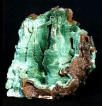

Malachite, Copper Hydroxyl Carbonate, ranges in color from light to dark green. The name comes from the Greek malache, “mallow.” It is commonly found near copper deposits. Pliny’s smaragdus medicus seems to have been this stone rather than an emerald.
Due to its color and association with copper, a metal usually dedicated to Venus, malachite was also well regarded by her followers. For this reason, it has become an amulet for the attraction of love, especially when engraved with her emblem and set in copper. Burn a green candle behind the stone for fifteen minutes a day, visualizing yourself in a loving relationship, to call love to you.
Druse forms of the stone encourage psychic ability, and stalactite forms support the quest for wisdom. In Rome, it was sometimes called the Peacock Stone, a bird associated with Juno. In the shape of a triangle, the stone was used as protection against the evil eye. Attached to a baby’s cradle, it would ward off evil spirits and dreams or warn of danger by suddenly cracking. Malachite is ancient protection against lightning and other natural dangers. According to Russian legend, anyone who drinks from a malachite goblet will understand the language of animals. The ancient Egyptians ground it to powder and used as an eye shadow, not only because of its rich and beautiful color, but also to enhance clear vision and insight.
Malachite is a stone of transformation, assisting in changing situations and spiritual evolution. Understanding and intuitive answers are provided by malachite. It helps the user reach goals by intuitively laying out the steps needed to arrive there. Fidelity, practicality, and responsibility are encouraged through its use.
Malachite assists in clearing and activating all chakras, especially the heart and throat. It is an excellent tool for clarifying emotions and releasing negative experiences. For the healer, malachite is useful in diagnosing disorders of the mind, body, and spirit. Malachite is said to be protective of those in flight and to assist in instances of vertigo. Ancient healers used malachite to sooth insect bites, powdered it in milk and drank it for stomach pain, and mixed it with honey for a wound salve. A 12th century medical text from China advocated the use of malachite for colds and diarrhea.